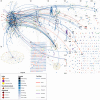Scientific Twitter: The flow of paleontological communication across a topic network
- PMID: 31361749
- PMCID: PMC6667199
- DOI: 10.1371/journal.pone.0219688
Scientific Twitter: The flow of paleontological communication across a topic network
Abstract
The field of paleontology, which is based principally on observations of the natural world, includes an active community that is engaged across multiple social media platforms, consisting of museums, academic researchers, amateur fossil collectors, paleontological artists, and commercial fossil dealers. As such, it represents an ideal environment for examining the people, interactions, and flow of scientific information. Using interactions involving the four most popular Twitter hashtags for paleontology, this embedded mixed methods study defined the members of this social world and investigated how they influenced and controlled the flow of information, as well as how their expression of scientific practice was related to their identity. Results provide further evidence for the diversity of people and practice involved in this domain of science and indicate that the magnitude and breadth of the public's impact may be larger than previously projected. Certain types of messages were shown to be effective for different segments of the community, but news posts, essentially media outlet stories, were ineffective for generating any form of engagement. This study adds to our understanding of the important scientific contribution being made by members of the public as they interact with professional scientists and educators as peers in an open social media platform that supports a diverse and active community.
Conflict of interest statement
The authors have declared that no competing interests exist.
Figures




References
-
- Dickinson J, Bonney R. Citizen Science: Public participation in environmental research Ithaca, NY: Comstock Publishing Associates; 2012.
-
- Ries L, Oberhauser K. A Citizen Army for Science: Quantifying the Contributions of Citizen Scientists to our Understanding of Monarch Butterfly Biology. Bioscience. 2015. April 1;65(4):419–30.
-
- Wenger E, White N, Smith JD. Digital habitats: stewarding technology for communities Portland, OR: CPsquare; 2009.
-
- Gibson JJ. The ecological approach to visual perception Hillsdale, N.J.: Lawrence Erlbaum Associates; 1986.
Publication types
MeSH terms
LinkOut - more resources
Full Text Sources
Research Materials

